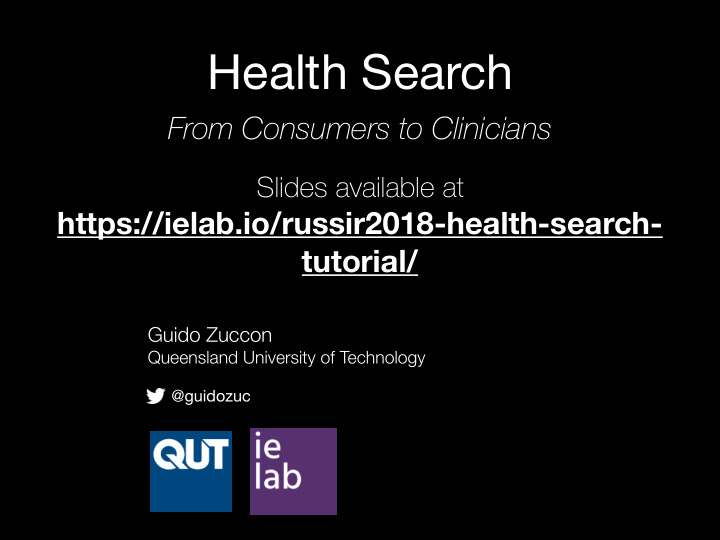



Health Search From Consumers to Clinicians Slides available at https://ielab.io/russir2018-health-search- tutorial/ Guido Zuccon Queensland University of Technology @guidozuc
Auxiliary Details on UMLS (not covered in tutorial)
Digging into the UMLS There UMLS • Metathesaurus: The heart of UMLS • Consists of over • 1,000,000 concepts � 3
The UMLS Metathesaurus UMLS tables - Many of them, but 2 key tables: • 1. MRConso.rrf: Links each concept (CUI) to each unique concept in a source vocabulary (AUI) Sample Records C0001175|ENG|P|L0001175|VO|S0010340|Y|A0019182||M0000245|D000163|MSH|PM|D000163|Acquired Immunodeficiency Syndromes|0|N|1792| C0001175|ENG|S|L0001842|PF|S0011877|N|A2878223|103840012|62479008||SNOMEDCT|PT|62479008|AIDS|9|N|3840| C0001175|ENG|P|L0001175|VC|S0354232|Y|A2922342|103845019|62479008||SNOMEDCT|SY|62479008|Acquired immunodeficiency syndrome|9|N|3584| C0001175|FRE|S|L0162173|PF|S0226654|Y|A7438879||M0000245|D000163|MSHFRE|EN|D000163|SIDA|3|N|| C0001175|RUS|S|L0904943|PF|S1108760|Y|A13488500||M0000245|D000163|MSHRUS|SY|D000163|SPID|3|N|| REL Description (Relat AQ Allowed qualifier 2. MRREL.rrf: inks 2 concepts with a CHD has child relationship in a Metathesaurus source vocabulary DEL Deleted concept relationship. Note the relationship is PAR has parent relationship in a Metathesaurus source vocabulary QB can be qualified by. RB has a broader relationship AUI to AUI RL the relationship is similar or "alike". the two concepts are similar or "alike". In the current RN has a narrower relationship RO has relationship other than synonymous, narrower, or broader RQ related and possibly synonymous. RU Related, unspecified SIB has sibling relationship in a Metathesaurus source vocabulary. SUBX Concept removed from current subset SY source asserted synonymy. � 4 XR Not related, no mapping Empty relationship
UMLS Semantic Network Categorise concepts and relationships among concepts. • Each UMLS concept is assigned to at least one semantic type (i.e., • defines the concept category). Semantic types are related by links: ”is a”, “part of”, “process of”, etc. • Part of ”is a” semantic hierarchy. Full hierarchy: https://www.nlm.nih.gov/research/umls/META3_current_semantic_types.html � 5
UMLS Semantic Network Links: Example � 6
UMLS Semantic Type Groups To reduce the complexity, semantic types are grouped • based on its: semantic validity, parsimony, completeness, exclusivity, naturalness, and utility. Semantic types within Semantic type group: ”Disorders” � 7
UMLS semantic network Detail: SRDEF Basic information about the semantic types and • relations Field Description RT: Record Type (STY = Semantic Type or RL = Relation). UI: Unique Identifier of the Semantic Type or Relation. STY/RL: Name of the Semantic Type or Relation. STN/ Tree Number of the Semantic Type or Relation. RTN: DEF: Definition of the Semantic Type or Relation. EX: Examples of Metathesaurus concepts with this Semantic Type (STY records only). UN: Usage note for Semantic Type assignment (STY records only). NH: The Semantic Type and its descendants allow the non-human flag (STY records only). ABR: Abbreviation of the Relation Name or Semantic Type. RIN: Inverse of the Relation (RL records only). 8 �
SRDEF Sample entries STY|T047|Disease or Syndrome|B2.2.1.2.1|A condition which alters or interferes with a normal process, state, or activity of an organism. It is usually characterized by the abnormal functioning of one or more of the host's systems, parts, or organs. Included here is a complex of symptoms descriptive of a disorder.||Any specific disease or syndrome that is modified by such modifiers as "acute", "prolonged", etc. will also be assigned to this type. If an anatomic abnormality has a pathologic manifestation, then it will be given this type as well as a type from the 'Anatomical Abnormality' hierarchy, e.g., "Diabetic Cataract" will be double-typed for this reason.||dsyn||S RL|T186|isa|H|The basic hierarchical link in the Network. If one item "isa" another item then the first item is more specific in meaning than the second item.||||IS|inverse_isa| � 9
UMLS semantic network Detail: SRSTR Structure of the network • STY/RL: Argument 1 (Name of a Semantic Type or Relation). RL: Relation ("isa" or the name of a non-hierarchical Relation). STY/RL: Argument 2 (Name of a Semantic Type or Relation); if this field is blank this means that the Semantic Type or Relation is one of the top nodes of the Network. LS: Link Status (D = Defined for the Arguments and its children; B = Blocked; DNI = Defined but Not Inherited by the children of the Arguments). Disease or Syndrome|conceptually_related_to|Experimental Model of Disease|DNI| Disease or Syndrome|isa|Pathologic Function|D| Disease or Syndrome|produces|Tissue|D| 10 �
Semantic Network Detail: SRSTRE1 OR SRSTRE2 Fully inherited set of Relations (UI's or Names ). • UI/STY: Argument 1 (UI or name of a Semantic Type). UI/RL: Relation (UI or name of a nonhierarchical Relation). UI/STY: Argument 2 (UI or name of a Semantic Type). N.B.: The relations expressed in this table are binary relations and the arguments are ordered pairs. All relations have been fully inherited in this table. SRSTRE1 SRSTRE2 T047|T186|T038| Disease or Syndrome|isa|Biologic Function| T047|T186|T046| Disease or Syndrome|isa|Pathologic Function| T047|T186|T051| Disease or Syndrome|isa|Event| T047|T186|T067| Disease or Syndrome|isa|Phenomenon or Process| T047|T186|T070| Disease or Syndrome|isa|Natural Phenomenon or Process| T047 = Disease or Syndrome 11 � T186 = is a
Recommend
More recommend